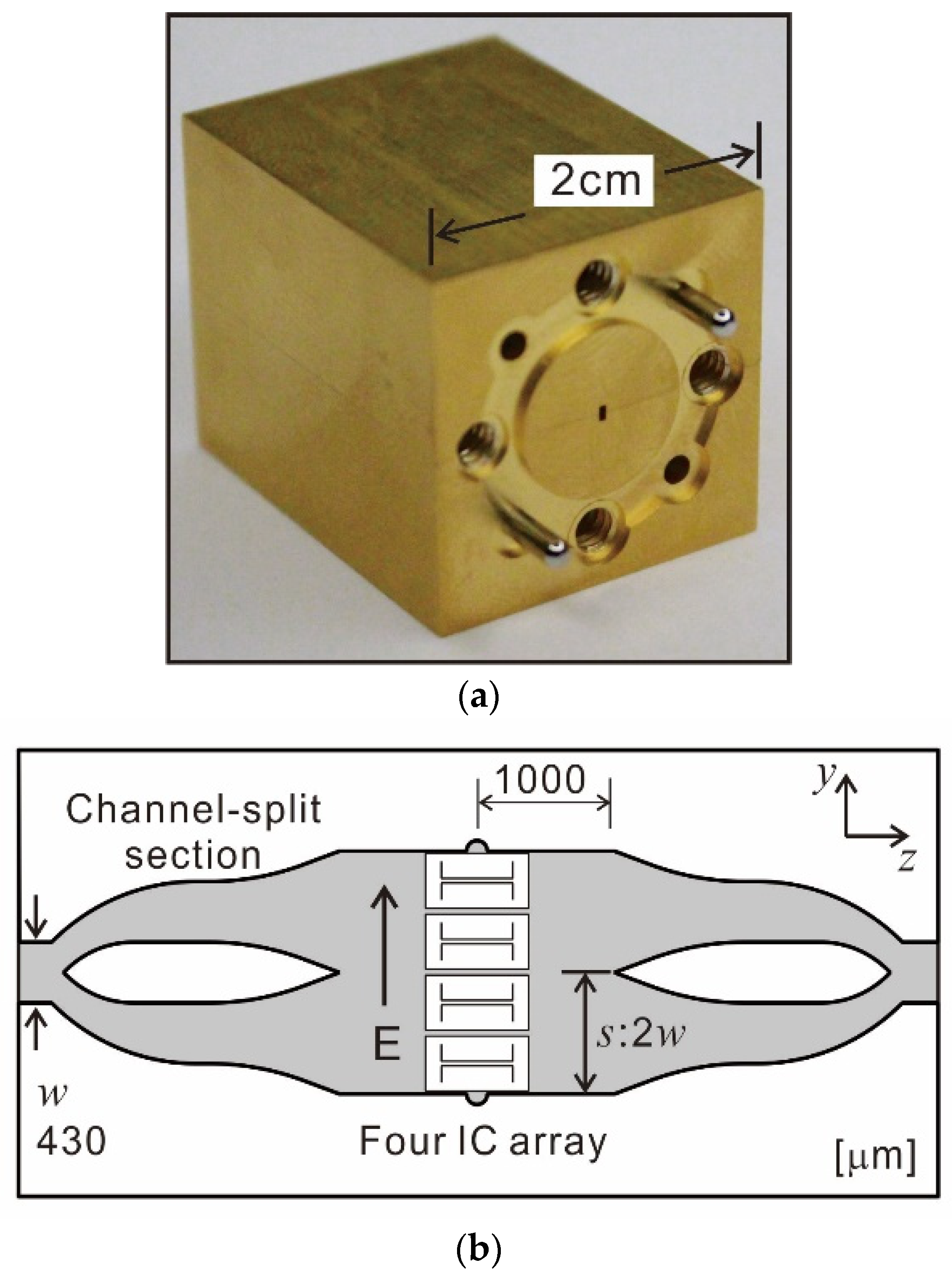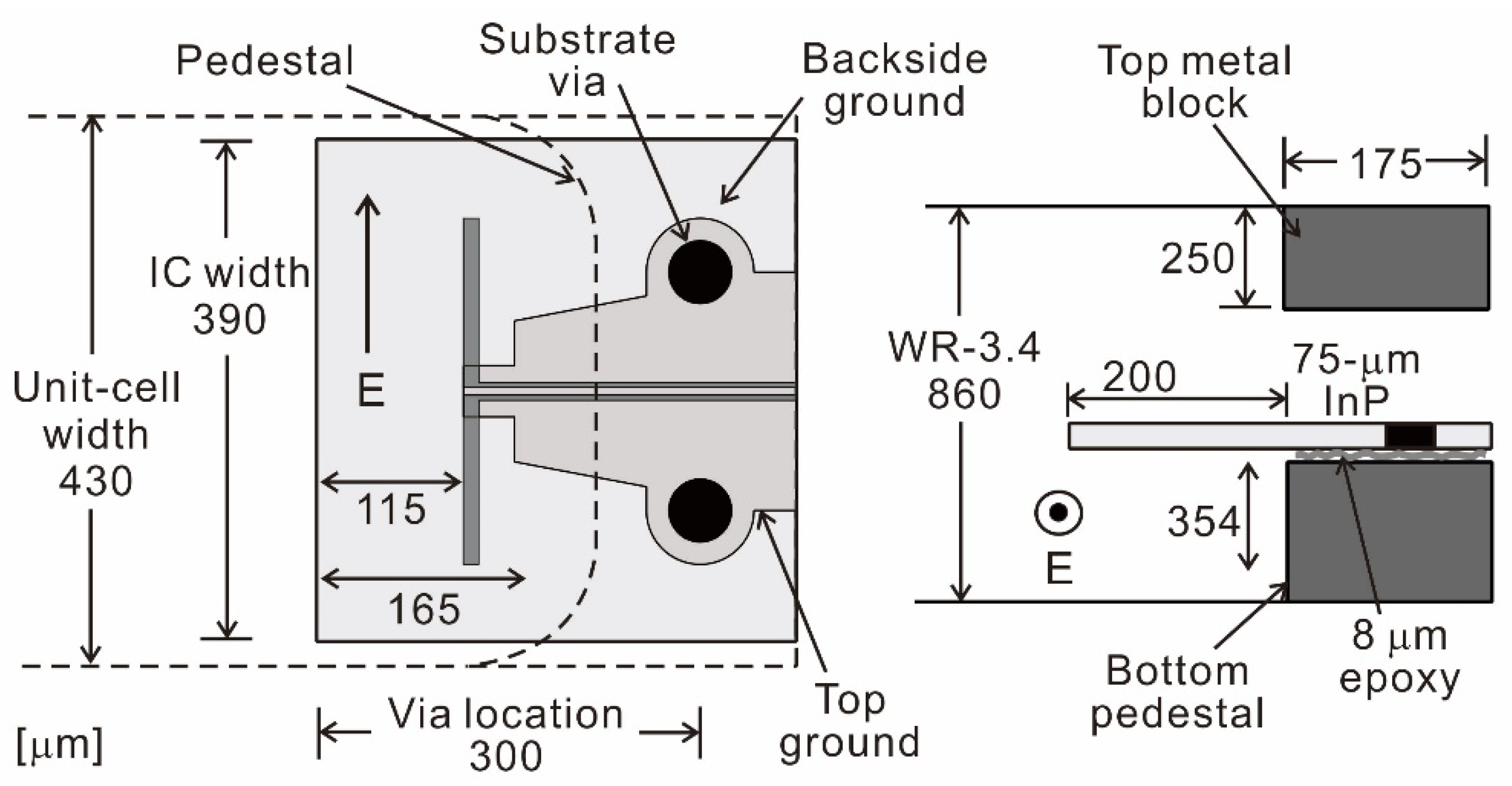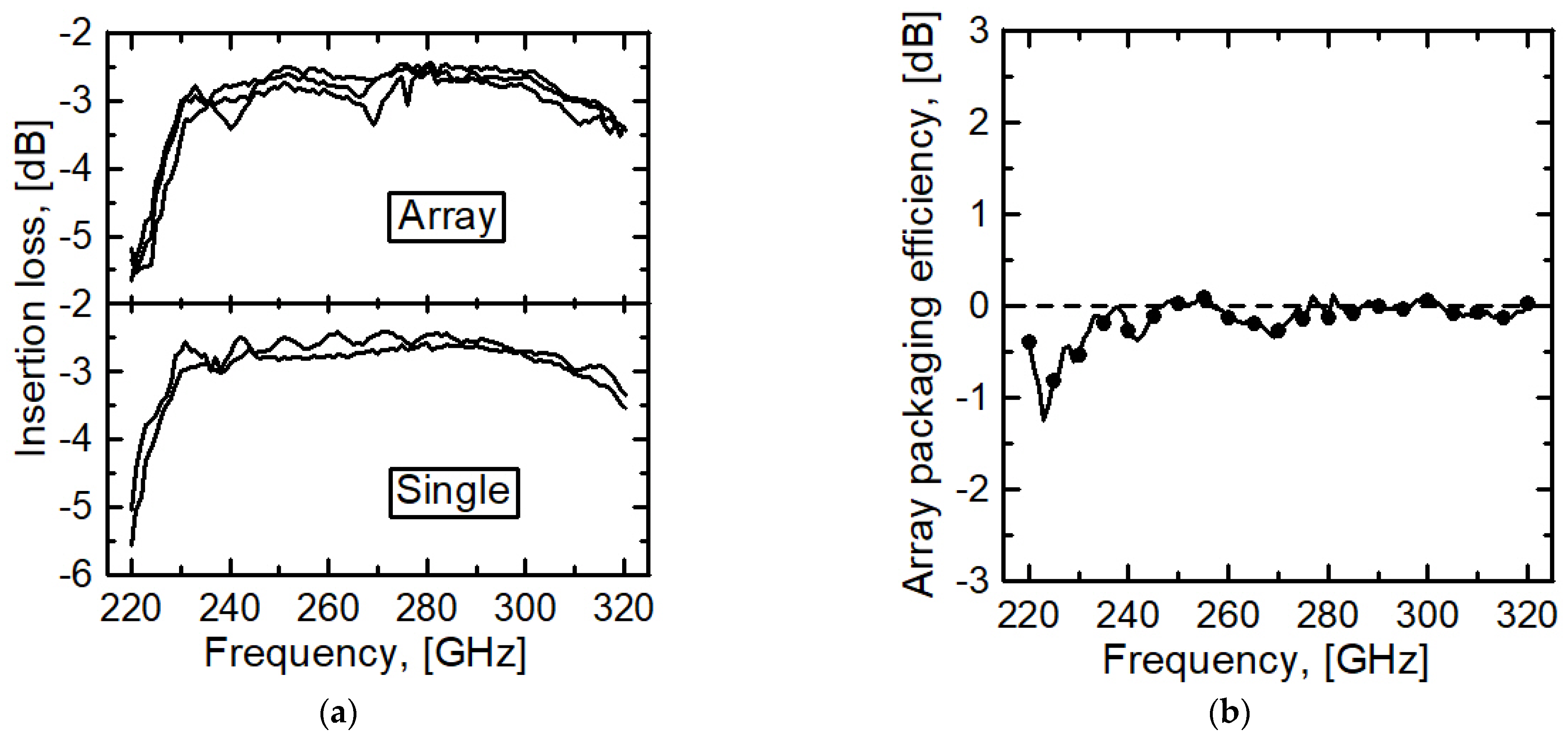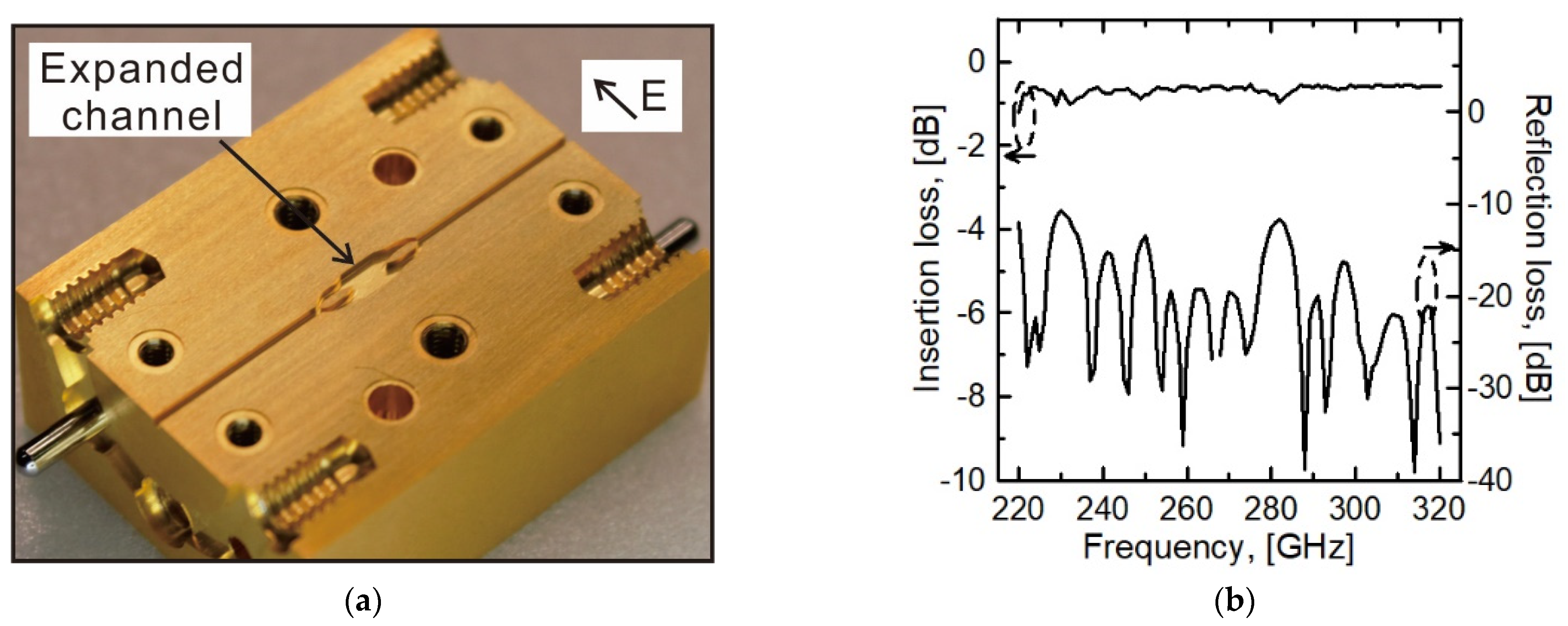WR-3.4 Overmoded Waveguide Module for the Packaging of a Linear Integrated-Circuit Array
Abstract
:1. Introduction
2. Array Module Assembly
3. Array Module Performance
4. Field Uniformity Test
5. Conclusions
Author Contributions
Funding
Conflicts of Interest
References
- Yu, H.G.; Choi, S.H.; Kim, M. 300 GHz InP HBT Amplifier with 10 mW Output Power. IET Electron. Lett. 2014, 50, 377–379. [Google Scholar] [CrossRef]
- Kim, J.; Jeon, S.; Kim, M.; Urteaga, M.; Jeong, J. H-Band Power Amplifier Integrated Circuits Using 250-nm InP HBT Technology. IEEE Trans. Terahertz Sci. Technol. 2015, 5, 215–222. [Google Scholar] [CrossRef]
- Ahmed, A.S.H.; Soylu, U.; Seo, M.; Urteaga, M.; Rodwell, M.J.W. A Compact H-band power amplifier with high output power. In Proceedings of the 2021 IEEE Radio Frequency Integrated Circuits Symposium (RFIC), Atlanta, GA, USA, 7–9 June 2021; IEEE: Piscataway, NJ, USA, 2021; pp. 123–126. [Google Scholar]
- Urteaga, M.; Griffith, Z.; Seo, M.; Hacker, J.; Rodwell, M.J.W. InP HBT Technologies for THz Integrated Circuits. Proc. IEEE 2017, 105, 1051–1067. [Google Scholar] [CrossRef]
- Wang, T.; Ning, Y.; Zhu, W. Design of an E-band power amplifier based on waveguide power-combining technique. In Proceedings of the 2018 International Conference on Microwave and Millimeter Wave Technology (ICMMT), Chengdu, China, 7–11 May 2018; IEEE: Piscataway, NJ, USA, 2018; pp. 1–3. [Google Scholar]
- Dang, Z.; Zhu, H.-F.; Huang, J.; He, H.-D. An Ultra-Wideband Power Combining in Ridge Waveguide for Millimeter Wave. IEEE Trans. Microw. Theory Tech. 2020, 68, 1376–1389. [Google Scholar] [CrossRef]
- Radisic, V.; Leong, K.M.K.H.; Sarkozy, S.; Mei, X.; Yoshida, W.; Liu, P.-H.; Deal, W.R.; Lai, R. 220-GHz Solid-state Power Amplifier Modules. IEEE J. Solid-State Circuits 2012, 47, 2291–2297. [Google Scholar] [CrossRef]
- Rollin, J.-M.; Miller, D.; Urteaga, M.; Griffith, Z.M.; Kazemi, H. A Polystrata 820 mW G-band Solid-state power amplifier. In Proceedings of the 2015 IEEE Compound Semiconductor Integrated Circuit Symposium (CSICS), New Orleans, LA, USA, 11–14 October 2015; IEEE: Piscataway, NJ, USA, 2015. [Google Scholar]
- Gritters, D.; Brown, K.; Ko, E. 200–260 GHz solid state amplifier with 700 mW of output power. In Proceedings of the IEEE MTT-S International Microwave Symposium, Phoenix, AZ, USA, 17–22 May 2015; IEEE: Piscataway, NJ, USA, 2015; pp. 1–3. [Google Scholar]
- Yi, C.; Cho, J.; Shin, J.; Kim, M. 260-GHz Waveguide Module Containing an Integrated InP HBT Amplifier Chip. Electron. Lett. 2020, 56, 665–667. [Google Scholar] [CrossRef]
- Maaskant, R.; Shah, W.A.; Zaman, A.U.; Ivashina, M.; Kildal, P.-S. Spatial Power Combining and Splitting in Gap Waveguide Technology. IEEE Microw. Wirel. Comp. Lett. 2016, 26, 472–474. [Google Scholar] [CrossRef] [Green Version]
- Yi, C.; Lee, H.; Lee, K.J.; Joo, J.H.; Kwon, J.B.; Kim, M. Uniform-field Over-mode Waveguide for Spatial Power-combining Applications. IEEE Microw. Wirel. Comp. Lett. 2018, 28, 10–12. [Google Scholar] [CrossRef]
- Yi, C.; Lee, K.M.; Kim, H.J.; Kim, M. WR-3.4 InP HBT Amplifier Module with Integrated Wideband Waveguide Transitions. IEEE Microw. Wirel. Comp. Lett. 2021, 31, 1315–1318. [Google Scholar] [CrossRef]






Publisher’s Note: MDPI stays neutral with regard to jurisdictional claims in published maps and institutional affiliations. |
© 2022 by the authors. Licensee MDPI, Basel, Switzerland. This article is an open access article distributed under the terms and conditions of the Creative Commons Attribution (CC BY) license (https://creativecommons.org/licenses/by/4.0/).
Share and Cite
Lee, J.; Kim, Y.W.; Jeon, S.; Kim, M. WR-3.4 Overmoded Waveguide Module for the Packaging of a Linear Integrated-Circuit Array. Electronics 2022, 11, 2091. https://doi.org/10.3390/electronics11132091
Lee J, Kim YW, Jeon S, Kim M. WR-3.4 Overmoded Waveguide Module for the Packaging of a Linear Integrated-Circuit Array. Electronics. 2022; 11(13):2091. https://doi.org/10.3390/electronics11132091
Chicago/Turabian StyleLee, Juhee, Yang Woo Kim, Sanggeun Jeon, and Moonil Kim. 2022. "WR-3.4 Overmoded Waveguide Module for the Packaging of a Linear Integrated-Circuit Array" Electronics 11, no. 13: 2091. https://doi.org/10.3390/electronics11132091
APA StyleLee, J., Kim, Y. W., Jeon, S., & Kim, M. (2022). WR-3.4 Overmoded Waveguide Module for the Packaging of a Linear Integrated-Circuit Array. Electronics, 11(13), 2091. https://doi.org/10.3390/electronics11132091




